Ber Insect and Mite Pests
Ber Insect and Mite Pests
Fruit fly
Biology:
- Egg: Female flies insert eggs under the skin of fruit in clusters of 10 to 50 about 1/25 to 1/8 inch below the fruit surface. The eggs measure about 1/25 by 1/250 inch and are white, elongate, and elliptical. They hatch in 1-1/2 days.
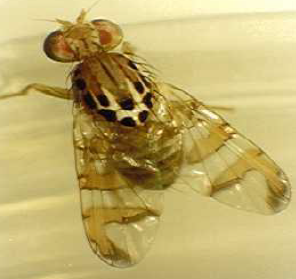 Larva: The white larva is legless, and resembles an elongated cone. The mouth is at the pointed end of the body. There are 3 larval stages, or instars. The third instar is about 2/5 inch long. The entire larval stage lasts for 11-15 days.
Larva: The white larva is legless, and resembles an elongated cone. The mouth is at the pointed end of the body. There are 3 larval stages, or instars. The third instar is about 2/5 inch long. The entire larval stage lasts for 11-15 days.- Pupa: When mature, larvae drop to the ground and pupate in the soil. The puparium is yellowish-brown and seed-like. Adults emerge in about 10 days.
- Adult: Generally, the abdomen has two horizontal black stripes and a longitudinal median stripe extending from the base of the third segment to the apex of the abdomen. These markings may form a "T" shaped pattern, but the pattern varies considerably. Females begin to lay eggs about 8 days after emergence from the puparium. Under optimum conditions, a female can lay more than 3,000 eggs during her lifetime, but under field conditions approximately 1,200 to 1,500 eggs per female is considered to be the usual production.
Damage symptom:
- Infestation starts with the onset of fruit setting.
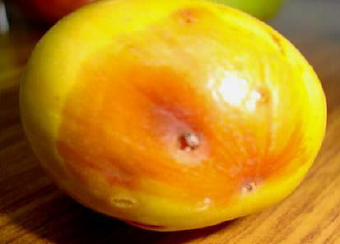
- The excreta of the larva accumulate in the galleries, which may sometimes result in rotting of the fruit.
- Infested fruits become deformed and their growth becomes checked. A large number of such fruits drop off.
Natural enemies of fruit fly:
Parasitoids: Fopius arisanus, Diachasmimorpha kraussi
Green slug caterpillar
Biology
- Egg: Eggs are laid in groups and covered with hairs on the leaves. Egg period is 4-5 days.
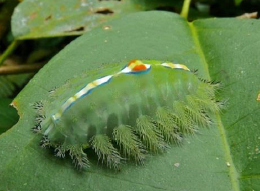
- Larva: Larva is stout, slug like ventrally flat, greenish body with white lines and four rows of spiny scoli tipped red or black; larval period is 40-45 days.
- Pupa: It pupates in plant as cocoons covered with irritating spines and hairs
- Adult: Adult moth is green with brown band at the base of each forewing.
Damage symptom:
- Larva feeds on leaves voraciously leaving only the midrib and veins resulting in severe defoliation
Mite
Biology:
- Egg: Eggs are oval shaped and white in colour. Eggs are glued firmly on the leaf surface. Eggs large, obovate, flattened at the bottom; eggs hatches after 27-32 hours.
- Nymph: Nymphs white in colour.
- Adult: Adults large, oval and broad and yellowish in colour. Females are yellowish and bigger than the males and they carrying the “female nymphs” on their back.
Damage symptom:
- Mite is seen on young leaves especially the top two to three leaves and the bud.
- Affected leaves become rough and brittle and corky lines.
- Downward curling.
- Internodes get shortened.
- Mites produce galls in floral buds preventing fruit production. Natural enemies of mite: Predators: Predatory mites, predatory thrips, Oligota spp., Orius spp. (pirate bug), hover flies, mirid bug
Grey Hairy caterpillar
Biology:
- Egg: Female lays eggs in masses on leaves.
- Larva: The larvae are pale yellow coloured with yellow hair over the body. They are polyphagous, feed on leaves and cause loss by way of defoliation. In severe cases only stems are left behind. In defoliated crops it also feeds on capsules.
- Pupa: Pupates in leaf litter close to the plants. There are several generation per year.
- Adult: Adult moth is reddish brown with black spots. Both the wings are pinkish and possess black spots
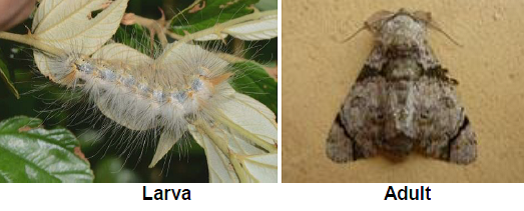
Damage symptom:
- Caterpillars feed on the young leaves and fruits.
- The older caterpillars spread in all directions and devour leaves and fruits and sometimes even tender shoots.
- They start eating new foliage as it grows after pruning and this is continued by overlapping generations.
Natural enemies of grey hairy caterpillars:
Predators: Chrysoperla Coccinellids
Bark eating caterpillar: Indarbela quadrinotata
Biology:
- Eggs: Spherical eggs, usually singly, are laid in bark cracks. 350 eggs on bark in MayJune, larval period is about 8-11 days. Number of generation : 1/year
- Larva: Larval period 8-10 months till about 3rd week of April. The larval stage is for about 10 months. The larva is brown to black, shiny, sparsely hairy and measures 4.5- 5.0 cm before pupation.
- Pupa: Pupation inside larval tunnel, pupal period is about 21-41 days.
- Adult: Moth is creamy white with brown markings on the forewing. Moth longevity is 3 days.
Damage symptom:
- The caterpillars feed on the bark of the tree during night.
- They bore inside the trunk or main stems and eat through the bark in to the wood.
- The affected portion is covered with large silken webs.
- In case of severe infestation plants may die.

Life Cycle:
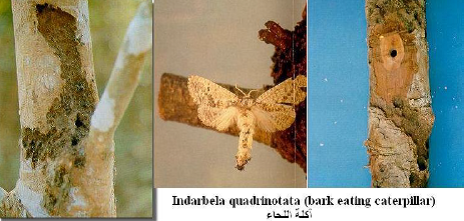
Leaf miner
Biology
- Egg: Egg are very tiny (about 1.0 mm long and 0.2 mm wide), greyish or yellowish white and slightly translucent. They are laid inside the leaf tissue, just below the leaf surface. In some instances eggs are laid below the epidermis of fruits/pods (e.g. peas). Eggs hatch in about 3 days.
- Larva: They are small yellow maggots (about 2 to 3 mm long when fully-grown). They are found feeding inside the leaf tissue, leaving a long, slender, winding, white tunnels (mines) through the leaf. They pass through 3 larval stages. After 5 to 7 days the maggots leave the mines and pupate either on the leaf surface or - more commonly - in the soil. In some cases, maggots pupate within the mines.
- Pupa: Pupae are very small, about 2 mm long and 0.5 mm wide) oval, slightly flattened ventrally with variable colour varying from pale yellow-orange to golden-brown. They have a pair of cone-like appendages at the posterior end of the body. Adults emerge 4 to 5 days after pupation.
- Adult: adults are small, about 2 mm long. They are greyish to b
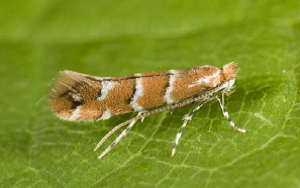 lack with yellow markings. Female flies are slightly larger than males. The life cycle varies with host and temperature. The average life cycle is approximately 21 days in warm conditions, but can be as short as 15 days. Thus, populations can increase rapidly.
lack with yellow markings. Female flies are slightly larger than males. The life cycle varies with host and temperature. The average life cycle is approximately 21 days in warm conditions, but can be as short as 15 days. Thus, populations can increase rapidly.
Fruit borer
The fruit borer Meridarchis scyrodes is a serious pest in Southern states of India.
Biology:
- Adult fly is small dark brown in colour with fringed wings. Early instar larva is light yellowish and full-grown larva is red in colour.
- Female lays an average of 13.29 eggs and incubation period found to be 4-5 days. The larval and pupal stages completed in 14-18 and 8-9 days, respectively.
- Under laboratory conditions at 31 ± 1°C and 60-80% R.H and life cycle completes within 26-32 days.
- Longevity of adult male and female observed to be 3-4 and 4-5 days, respectively.
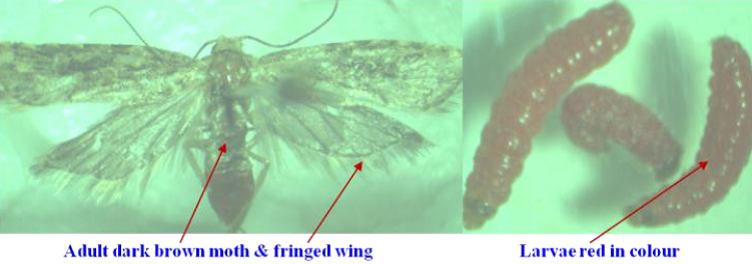
Damage symptoms:
- The pest causes up to 70% yield loss under severe infestation. The moths lay eggs on fruits at pea stage and upon hatching the newly emerged caterpillars bore into fruits and feed on the pulp near seed and accumulate fecal.
- The first and second instar larvae feeds on the fruit superficially but third to fifth instar larvae feeds internally and damages the pulp around the seed. At initial stages of fruit development, the full grown larvae found to feed on soft immature seed.
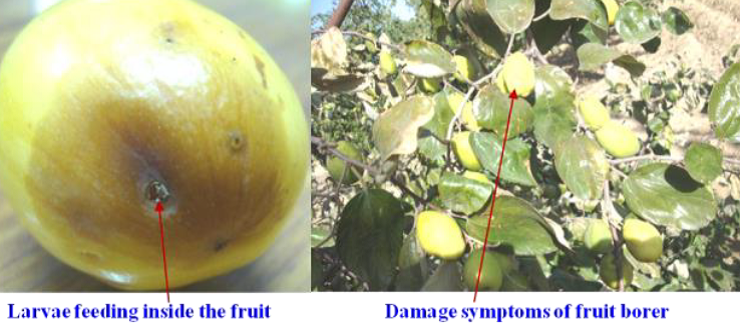
Stone weevil
Occurrence and distribution:
- The stone weevil, A. himalayanus is recorded as a new pest of ber. At first it was recorded as a new pest of ber for the first time from Andhra Pradesh state of India.
- Later, from Rahuri, Maharashtra and Jobner, Rajasthan of India in 1996 and recently in Bikaner district of Rajasthan, India during 2010.
- Apart from India, the severe damage of this pest at early stage of fruit development has also been reported from Bangladesh.
Biology:
- The adult weevils are small dark in colour with snout. The grubs are white in colour with red marking on the bogy, which are present inside the seeds (Karuppaiah et al., 2010). The activity of adult beetle could be observed in the field during morning and evening hours and the biology of this pest is not studied so far.
Life cycle:
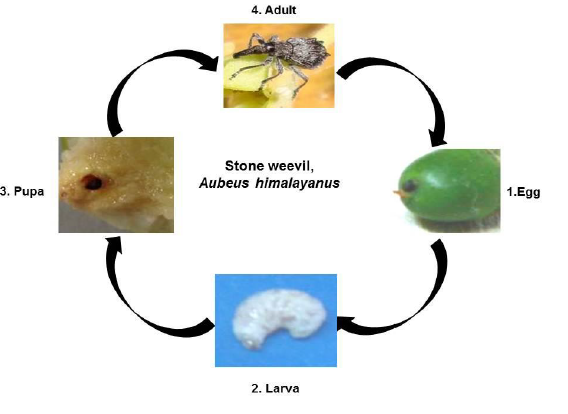
Damage symptoms:
- Grubs directly damage the fruits by tunneling inside seeds and adult weevil also blemishes mature fruit by ovi-punctures. The activity of adult beetle could be observed in the field during morning and evening hours.
- The adult female weevil lays their eggs mostly on the stylar end; rarely on the distal end of fruits and egg laid punctures covered with brown encrustation.
- Upon hatching, the grubs enter into seed by puncturing endocarp at immature stage and starts feeding on soft seed coat. Later it enters into endosperm moving downward. After entering the seed, it starts feeding on inner content of the seed, and pupates within the seed by making hallow galleries.
- The weevil completes its life within a single fruit. The developing soft seed was completely eaten away by the pest. At the time of fruit maturity, in the hollowed area, infested fruits had a grub, a pupa or an adult.
- The infestation occurs in all the fruit stages; however, it is prevalent in pea to pebble size fruits. Infested fruits are abnormal shape and nearly half portion of the fruit towards stalk turns reddish brown with rough surface and the remaining half portion towards stylar region remains greenish colour. Often, infested fruits fail to attain full maturity.
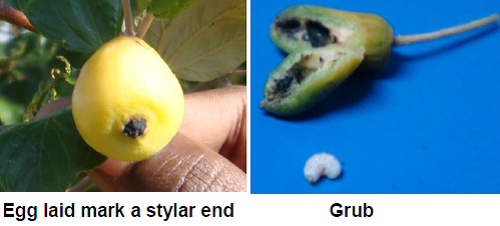
IPM for Ber
To know the IPM practices for Ber, click here.
Source: NIPHM; Directorate of Plant Protection, Quarantine & Storage
Last Modified : 3/22/2020
This topic covers the information related to Insec...
This topic covers information about Ber Diseases.
This topic covers the information related to insec...
This topic covers information about Ber Pests.
